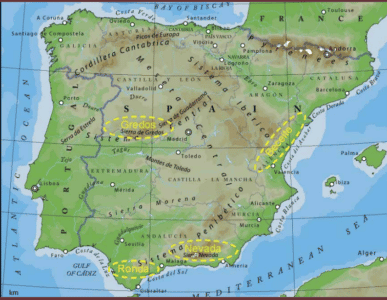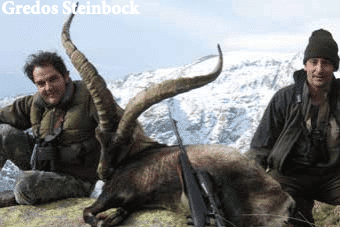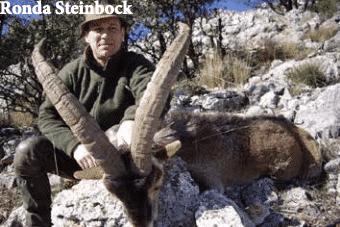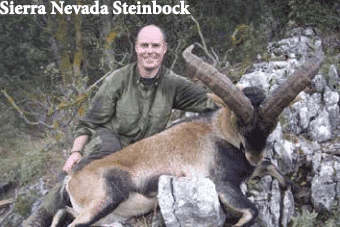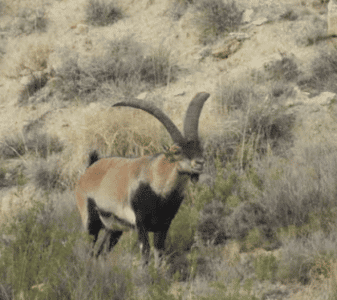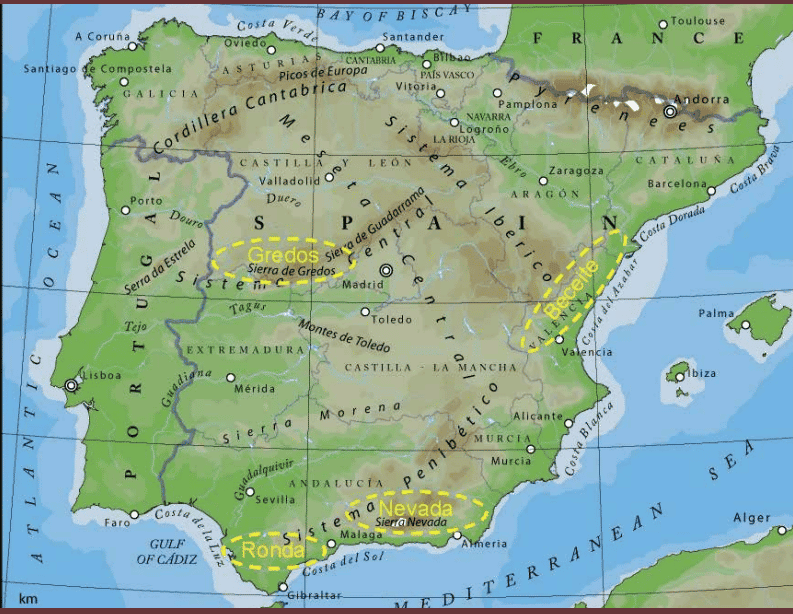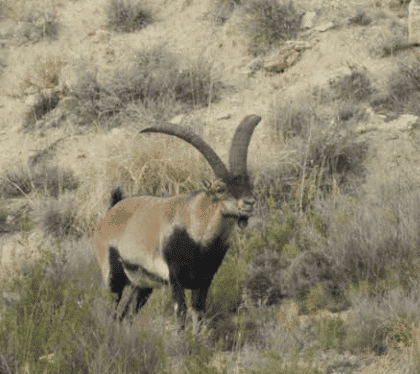Ibex special offer - Management hunt Spain
Ibex
Ibex special offer - Management hunt Spain
Location: Madrid, Spain
From: Who is offering this hunt

Hunting time: 01. October - 31. May
Description:3 nights, 2 hunting days, accommodation (double room) in country hotels and Paradors, hunting guidance 1:1, transfer in the hunting area, transfer from the airport to the hunting area h/z, field preparation of the trophy, English speaking Accompaniment, including shooting of 1 ibex under 6 years and 1 ibex ..more offer details
Other users also looked at the following:
Offer description
Steinwild Sonderangebot - Hegejagd in Spanien
Angebot und Preis nur bei Buchung von 2 Jägern gültig
3 Übernachtungen, 2 Jagdtage, Unterkunft (Doppelzimmer) in Landhotels und Paradors, Jagdführung 1:1, Transfer im Jagdgebiet, Transfer vom Flughafen ins Jagdgebiet h/z, Feldpräparation der Trophäe, englischsprachige
Begleitung, inkl. Erlegung von 1 Steinbock unter 6 Jahren und 1 Steingeiss
Spanien – das ist die Heimat der Iberischen Steinböcke.
Es gibt 4 bejagbare Unterarten: Den Beceite-, Gredos-, Ronda- & Sierra-Nevada-Steinbock. Wir bieten diese überaus erfolgreichen Jagden bereits seit vielen Jahren an und wir können mit Stolz und Recht behaupten, das all unsere Jäger bisher zum Schuss gekommen sind. Genießen auch Sie herrliche Jagdtage, verbunden mit der mediterranen Lebensart.
Da die Iberischen Steinböcke oft nur in Nuancen voneinander abweichen, haben wir umfangreiches Informationsmaterial über das Jagdland Spanien zusammengestellt.
Beceite-Steinbock:
Diese Unterart ist ebenfalls sehr begehrt und lebt in dem gleichnamigen Gebirge
in Ostspanien nahe der Mittelmeerküste. Es ist die vom Wildbretgewicht stärkste Unterart und hat die dunkelste Decke aller spanischen Steinböcke. Von der Hornlänge her kann man den Beceite- mit dem Gredos-Steinbock vergleichen. Im Gegensatz zum Gredos-Steinbock wachsen die Schläuche gerader und drehen spiralförmig nach außen. Kennzeichnend für diese Spezies ist der gleich bleibende Hornumfang bis in das mittlere Drittel, der sich bis zur Spitze nur unwesentlich verjüngt. Bejagbar ist der BeceiteSteinbock vom 15. Okt. bis 31. Mai. Dank der strengen spanischen Schutzbestimmungen sind die Bestände in den vergangenen 20 Jahren so stark angestiegen, dass selbst verwöhnte Jäger sich ´ihren Steinbock´ aussuchen können. Die Berge des Beceite (ein Gebirge in Ostspanien, an der Mittelmeerküste) sind gut begehbar und auch für den weniger fitten Jäger geeignet. Außerdem wird mit Pferden gejagt und das ist natürlich weitaus weniger beschwerlich als eine Fußpirsch.
Gredos-Steinbock
In Zentralspanien, westlich der Hauptstadt Madrid, in den Provinzen Avial, Toledo und Cacerres liegen die malerischen Berge des Gredos. Höchster Berg ist der Pico Almanzor mit 2.592 m. Hier wird der Gredos-Steinbock bejagt, eine der bekanntesten Unterarten. Die Böcke werden bis etwa 80 kg schwer und die Hörner, bis zu der Windung nach gemessen, 95 cm lang. Beeindruckend auch die Hornbasis, die bei Spitzentrophäen bis zu 28 cm betragen kann. Schmuckwülste, ähnlich wie wir sie von den Bezoaren oder den Sibirischen Steinböcken her kennen, sind nicht oder nur kaum vorhanden. Der Querschnitt eines Horns ähnelt einem Dreieck. Die Hornformen sind, wie bei allen Boviden, nicht so vielfältig wie bei Hirsch oder Reh. In der Regel weist das Gehörn eine Lyraform auf. Im Gegensatz zur Lyraform der Cerviden (z. B. beim Rehbock) wachsen die Schläuche des Gredos Steinbockes von der Basis aus nach oben, bevor sie sich nach dem ersten Drittel zur Seite krümmen um sich dann im letzten Drittel wieder nach hinten und oben zu drehen. Nach den Steinböcken des Beceite Gebirges ist die Gredos Unterart die vom Gewicht her zweitstärkste Unterart. Für den passionierten Steinbockjäger eine eindrucksvolle Trophäe, die man in seiner Sammlung haben sollte. Steinböcke sind Tagwild, die Bestände hoch, die Pirschführer erfahren und daher reichen in der Regel zwei oder drei Jagdtage aus, Sie zum Schuss zu bringen. Jagen können Sie auf den Gredos-Steinbock vom 1.September bis 31. Mai. Während der gesamten Zeit haben Sie die besten Chancen. Sie können also Ihre Reiseplanung nach Ihrem Terminkalender richten und sind nicht an feste Zeiten gebunden.
Die kleinste Art ist der Ronda-Steinbock.
Diese Population lebt in Südspanien in einer Gebirgskette gleichen Namens. Die Berge sind nicht so hoch wie in den anderen Gebirgen Spaniens und deshalb insbesondere auch für solche Jäger geeignet, die nicht mehr so ´gut auf den Läufen´ sind. Auch wenn die Hornlängen selten mal über 68 cm lang werden, erfreut sich gerade diese Unterart bei deutschen Jägern großer Beliebtheit. Denn der Ronda Steinbock ähnelt in der Hornform am meisten dem allseits bekannten Alpensteinbock (wenn auch in kleineren Dimensionen). Die Decke ist meist hellbraun gezeichnet und es ist schon ein fantastischer Anblick, wenn man ein ´Altherrenrudel´ vor sich hat. Für alle spanischen Arten gilt: Dank der strengen Schutzbestimmungen und dank des hohen Stellenwertes – auch der spanische König ist ein passionierter Steinbockjäger – sind alle Bestände so gut, dass man mit an Sicherheit grenzender Wahrscheinlichkeit zum Schuss kommen wird. Jagdzeit ist vom 1. Oktober bis 30. April.
Der Sierra-Nevada-Steinbock - oder auch Grenada Steinbock genannt - ist die vierte bejagbare Art der Iberischen Steinböcke. Er lebt in den Gebirgszügen der Sierra Nevada (Südspanien, nahe der Stadt Malaga) in einem relativ großen Einstandsgebiet. Gerade bei dieser Unterart gibt es eine Vielzahl von Hornformen. Im Wildbret ist er etwas schwächer als die Böcke aus dem Gredos und des Beceite, aber schwerer als diejenigen aus dem Ronda-Gebirge.
Die Deckenfarbe ist in der Regel mittelbraun, aber auch hier gibt es Abweichungen ins Hellere oder Dunklere. Bei Spitzentrophäen wurden Hornlängen von bis zu 88 cm gemessen, der Durchschnitt dürfte aber bei etwa 70 cm bis 75 cm liegen. Bejagbar ist diese Unterart vom 1. Oktober bis 30. April.
Etwas zu den Steinbockjagden in Spanien:
Wegen der Nähe zu Deutschland (manch einer scheut sich vor Jagden in Kasachstan oder Kirgisien), erschwinglichen Preisen und problemloser Anreise mit Waffen (Spanien gehört zur Europäischen Union) erfreuen sich die Steinbockjagden stetig wachsender Beliebtheit. Zumal Sie in vier verschiedenen reizvollen Gegenden dieses interessanten Jagdlandes vier verschiedene Spezies von ´capra pyrenaica´ bejagen können. Steinwild ist Gebirgswild, das lässt sich nicht wegdiskutieren. Aber alle Gebirge Spaniens sind, soweit es Einstandsgebiete der Steinböcke sind, gut begehbar. Sie brauchen also kein Alpinist zu sein, eine normale Kondition reicht aus. Und noch ein wesentlicher Punkt spricht für Spanien. Zeit ist in unserer hektisch gewordenen Gesellschaft ein wertvolles Gut. Und da die Steinbockjagden inklusive Hin- und Rückflug nur 4 Tage dauern und man auch das Wochenende mit einfließen lassen kann, muss man nur wenig Urlaub opfern. Aber glauben Sie uns, es lohnt sich. Die einzelnen Gebirge zu beschreiben, ist kaum möglich und würde den Platz dieser Informationsschrift sprengen. Man muss die herrlichen Landschaften selber gesehen, man muss dort gepirscht haben, um die Schönheiten dieser Regionen wiedergeben zu können.
Die Jagd hat in Spanien einen hohen Stellenwert – König Juan Carlos geht selbst gerne und viel zur Jagd – und entsprechend hoch wird der Jäger angesehen, anders als zum Teil bei uns. Dazu kommt die mediterrane Lebensart, man sieht alles viel lockerer. Und trotzdem sind die Erfolgsquoten bei diesen Steinbockjagden sehr hoch und selten das mal ein Jäger als ´Schneider´ nach Hause kommt. Aber dann wird im Jagdprotokoll sicherlich stehen: …viele Fehlschüsse !
Zur Steinbockjagd empfehlen wir Kaliber im oberen Leistungsbereich wie z.B. 6,5 x 68, 8 x 68 S und alle Kaliber aus der .300-er Gruppe z.B. (Winchester oder Weatherby). Unsere heimischen und gebräuchlichen Schalenwildkaliber wie .308, .30-06 und 7 x 64 stoßen bei Schussentfernungen von über 200 m schnell an ihre Grenzen.
Haben Sie Ihren Steinbock erlegt, sprechen Sie mit Ihrem Pirschführer, wie die Trophäe behandelt werden soll. Wünschen Sie ein Kopf - Schulterpräparat oder sind Sie nur an Horn und Schädel interessiert? Ihr spanischer Begleiter wird dafür sorgen, dass alles reibungslos hergerichtet wird. Der Trophäentransport innerhalb der EU ist problemlos, viele Jäger lassen deshalb die Präparate in Spanien anfertigen. Wir beraten Sie gerne und geben Ihnen wertvolle Tips.
3 nights, 2 hunting days, accommodation (double room) in country hotels and Paradors, hunting guidance 1:1, transfer in the hunting area, transfer from the airport to the hunting area h/z, field preparation of the trophy, English speaking
Accompaniment, including shooting of 1 ibex under 6 years and 1 ibex
Spain - this is the home of the Iberian ibex.
There are 4 huntable subspecies: The Beceite, Gredos, Ronda & Sierra Nevada Ibex. We have been offering these extremely successful hunts for many years and we can proudly say that all of our hunters have been able to shoot. You too can enjoy wonderful hunting days combined with the Mediterranean way of life.
Since the Iberian ibexes often only differ in nuances, we have put together extensive information about Spain as a hunting country.
Beceite Capricorn:
This subspecies is also very popular and lives in the mountains of the same name
in eastern Spain near the Mediterranean coast. It is the strongest subspecies by venison weight and has the darkest coat of any Spanish ibex. In terms of horn length, the Beceite ibex can be compared to the Gredos ibex. In contrast to the Gredos Capricorn, the tubes grow straighter and spiral outwards. Characteristic of this species is the constant horn circumference up to the middle third, which tapers only slightly up to the tip. The Beceite ibex can be hunted from October 15th to May 31st. Thanks to the strict Spanish protection regulations, the stocks have increased so much in the past 20 years that even spoiled hunters can choose 'their ibex'. The mountains of the Beceite (a mountain range in eastern Spain, on the Mediterranean coast) are easily accessible and also suitable for the less fit hunter. Horses are also used for hunting and this is of course far less arduous than stalking on foot.
Gredos Ibex
In central Spain, west of the capital Madrid, in the provinces of Avial, Toledo and Cacerres lie the picturesque Gredos Mountains. The highest mountain is the Pico Almanzor at 2,592 m. The Gredos ibex, one of the best-known subspecies, is hunted here. The bucks weigh up to about 80 kg and the horns, measured up to the whorl, are 95 cm long. Also impressive is the base of the horn, which can be up to 28 cm in top trophies. Decorative ridges, similar to those we know from the bezoars or the Siberian ibexes, are not or only rarely present. The cross section of a horn resembles a triangle. As with all bovids, the horn forms are not as varied as with deer or roe deer. As a rule, the horns have a lyre shape. In contrast to the lyre form of the cervids (e.g. the roebuck), the tubes of the Gredos ibex grow upwards from the base before they curve to the side after the first third and then turn backwards and upwards again in the last third. After the ibex of the Beceite Mountains, the Gredos subspecies is the second heaviest subspecies in terms of weight. An impressive trophy for the passionate ibex hunter that should be in your collection. Ibex are diurnal, the stocks are high, the guides are experienced and therefore two or three hunting days are usually enough to get you shooting. You can hunt for the Gredos ibex from September 1st to May 31st. All the while you have the best chance. So you can plan your travel according to your schedule and are not tied to fixed times.
The smallest species is the Ronda ibex.
This population lives in southern Spain in a mountain range of the same name. The mountains are not as high as in the other mountains in Spain and are therefore particularly suitable for hunters who are no longer so 'good on their legs'. Even if the horn lengths rarely exceed 68 cm, this subspecies in particular is very popular with German hunters. Because the horn shape of the Ronda ibex most closely resembles the well-known Alpine ibex (albeit in smaller dimensions). The ceiling is mostly light brown and it is a fantastic sight when you have a 'pack of old men' in front of you. The following applies to all Spanish species: Thanks to the strict protection regulations and thanks to the high status - the Spanish king is also a passionate ibex hunter - all stocks are so good that it is very likely that you will get a shot. Hunting season is from October 1st to April 30th.
The Sierra Nevada ibex - also known as the Grenada ibex - is the fourth huntable Iberian ibex species. It lives in the Sierra Nevada mountains (southern Spain, near the city of Malaga) in a relatively large home range. This subspecies in particular has a large number of horn shapes. In venison he is somewhat weaker than the bucks from Gredos and Beceite, a About heavier than those from the Ronda Mountains.
The ceiling color is usually medium brown, but here too there are deviations to lighter or darker. Horn lengths of up to 88 cm have been measured for top trophies, but the average should be around 70 cm to 75 cm. This subspecies can be hunted from October 1st to April 30th.
Something about the ibex hunts in Spain:
Due to the proximity to Germany (some people shy away from hunting in Kazakhstan or Kyrgyzstan), affordable prices and easy arrival with weapons (Spain is part of the European Union), ibex hunts are enjoying ever-increasing popularity. Especially since you can hunt four different species of 'capra pyrenaica' in four different attractive areas of this interesting hunting country. Ibex is mountain game, that cannot be argued away. But all of Spain's mountains, as far as they are home to the ibex, are easily accessible. So you do not need to be an alpinist, a normal level of fitness is sufficient. And another important point speaks for Spain. Time is a valuable commodity in our hectic society. And since the ibex hunts including the outward and return flight last only 4 days and you can also include the weekend, you only have to sacrifice a little holiday. But believe us, it's worth it. Describing the individual mountains is hardly possible and would go beyond the space of this information sheet. You have to see the magnificent landscapes yourself, you have to have stalked them to be able to reflect the beauties of these regions.
Hunting is very important in Spain - King Juan Carlos himself likes to hunt a lot - and the hunter is held in high esteem accordingly, unlike some of our countries. In addition, there is the Mediterranean way of life, you see everything much more relaxed. And yet the success rates for these ibex hunts are very high and it is rare for a hunter to come home as a 'tailor'. But then the hunting log will certainly say: ...many missed shots!
For ibex hunting, we recommend calibers in the upper power range, such as 6.5 x 68, 8 x 68 S and all calibers from the .300 group, e.g. (Winchester or Weatherby). Our domestic and common hoofed game calibers such as .308, .30-06 and 7 x 64 quickly reach their limits at shooting distances of over 200 m.
Once you have bagged your ibex, speak to your guide about how the trophy should be treated. Would you like a head and shoulder specimen or are you only interested in the horn and skull? Your Spanish guide will ensure that everything is set up smoothly. The transport of trophies within the EU is not a problem, so many hunters have the preparations made in Spain. We will be happy to advise you and give you valuable tips.
Territory information
Languages: English
Hunting methods: Stalking
The package deal includes
Class: unter 6 J.
Included in the price: 1 animal(s)
Included in the price: 1 animal(s)
Travel date
0 chosen hunting day(s)
0 additional travel day(s)
Sum: 0 days with 0 overnights
Your selected travel date
12.07.2025
(Arrival day)31.05.2026
(Departure day)Daily rate and accommodation
Facilities:
More information:
Other costs:
Gun rental
Non hunting person(s)
Ausfuhrpapiere und Veterinärzertifiktat pro Steinbock
Transfer:
Trophy treatment:
-
Shooting distances:
-
Caliber recommendation:
-
Missed shot:
0 % of the estimated trophy price
Payment:
Deposit: 50 % of the total price
Final payment: On site
Wounding:
100 % of the estimated trophy price
Angeschweißt gilt als erlegt
Cancellation:
Deposits are non-refundable
Included in the offer:
- Accommodation
- Guidance
- Trophy treatment: Feldpräparation
- Transportation in territory
- Transportation from/to airport/railway station
NOT included in the offer:
- Alcoholic drinks
- Service fee
- Trophy export
- Tips
